Recent Articles
Popular Makes
Body Types
2015 Hyundai Sonata Mid-Size Sedan First Drive And Review
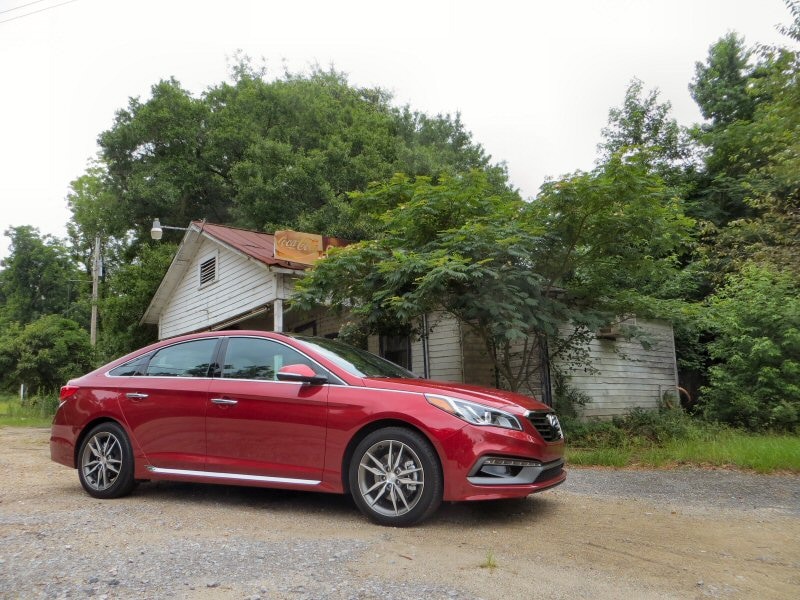
2015 Hyundai Sonata ・ Photo by Benjamin Hunting
The all-new 2015 Hyundai Sonata is charged with a difficult task: following up what has become the biggest success story in the history of the Korean brand. The previous-generation mid-size Sonata sedan firmly established the automaker as a legitimate player in the four-door family car market, nearly doubling the sales volume of its predecessor and forcing long-popular nameplates like the Toyota Camry and Honda Accord to step up their game in a bid to retain dominance in a rapidly-democratizing segment.
The Hyundai Sonata that was introduced in 2011 managed these impressive achievements by accenting value, revolutionizing the build quality of the car, and taking a risk with expressive, stand-out styling. One would assume that its successor would take its cues from a similar playbook, but that’s not the case - while the 2015 Hyundai Sonata certainly aims to maintain its edge in reliability and return on investment, that crucial third leg of the tripod that supported so many new Sonata customers has lost its sheen. In a bid to cement its newfound player status Hyundai has pointed the Sonata down a more ‘mature’ (read ‘conservative’) design road that may or may not be a step backward for what was once a compelling alternative to look-alike sedan options from its Japanese and domestic rivals.
Wanting To Fit In
One of the funny things about getting a taste of what the establishment has to offer is that it can sometimes make you forget about what it took for you to knock that door down in the first place. The 2015 Hyundai Sonata has unquestionably softened its outsider status by adopting what it calls the ‘Fluidic Sculpture 2.0’design language, a collection of broader, more homogenous cues that also figure prominently on the recently-refreshed Hyundai Genesis full-size sedan. Whereas the sedan that the Sonata replaces was a remarkable arrangement of flowing sheet metal and glass that resembled little else in the mid-size class when it was first introduced, it’s easy to pick out aspects of the new car and match them with similar vehicles like the Nissan Altima, the Subaru Legacy, and the Toyota Camry.
Hyundai has attempted to stir the pot at least a little bit with the introduction of a new Sport trim that grafts on a somewhat more aggressive bumper treatment as well as quad exhaust tips, but it’s not as vital an effort as one would expect from such a design-oriented company. While on paper the decision to dilute the Sonata’s image in the service of mass appeal might have made a strong business case, when seen in three dimensions the car comes across as more inoffensive than memorable. An exception can be made for the Hyundai Sonata’s rear three-quarter view, as its revised bumper and LED tail lights present the most appealing set of changes to the eye.
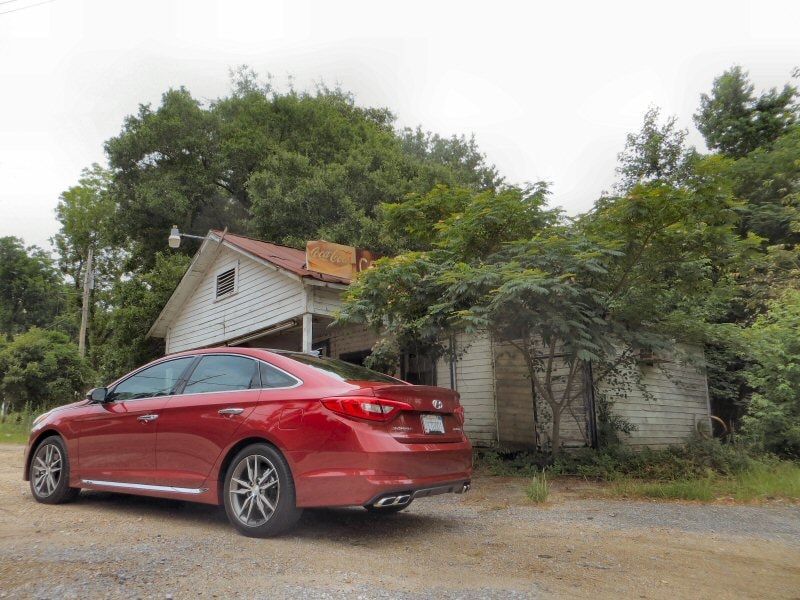
Photo by Benjamin Hunting
A Good Interior Made Better
Much of what made the 2014 Hyundai Sonata’s passenger compartment so compelling has been preserved in the 2015 model, and areas that needed improvement have been addressed. Specifically, there’s still a fantastic amount of room to be found front and rear inside the sedan, which the EPA actually classifies as a full-size model despite its mid-size market position. It’s very easy to get comfortable when riding inside the Sonata, a testament both to its seats and the amount of space that has been carved out of a platform that is the widest in the segment (and one that has gained only slightly in terms of overall length due to the extension of front crumple zones).
It’s the dashboard of the redesigned Sonata that sees the biggest improvement, moving from a vertically-oriented center stack to one that stretches out left and right to push a greater number of control services into the driver’s line of site. It’s a strategy that works quite well as I had no difficult accessing climate and entertainment knobs from the left front seat. I also enjoyed the new touchscreen infotainment system that’s available on pricier editions of the Hyundai, an eight-inch setup matched with physical buttons that bring up commonly used features quickly and efficiently. A more affordable, but less flashy five-inch touchscreen is also offered with the Sonata, while a simple multi-line LCD display handles the base model’s stereo controls.
Sport trim levels again get special attention, introducing a flat-bottom steering wheel, paddle shifters for interacting with the car’s automatic transmission, and a gauge cluster that makes use of what Hyundai terms ‘six-o’clock’ dials for the tachometer and speedometer. While the standard Sonata’s dash is certainly attractive, the Sport makes things feel that much more special.

Photo by Benjamin Hunting
Safety Stays Paramount
Not to be left out when discussing the 2015 Hyundai Sonata is its emphasis on providing drivers with a range of advanced safety features. In addition to a new crash structure, the car also features an available blind spot monitoring system, a rear cross traffic alert system, and even adaptive cruise control with forward collision warning capability. The latter functions regardless of whether cruise is activated or not and truth be told was a bit sensitive during my drive, to the point where it picked up oncoming traffic around curves on more than one occasion. To have this level of safety equipment available in an affordable mid-size sedan is impressive, particularly when considering that there are certain luxury cars that haven’t yet adopted the Sonata’s full range of available gear.
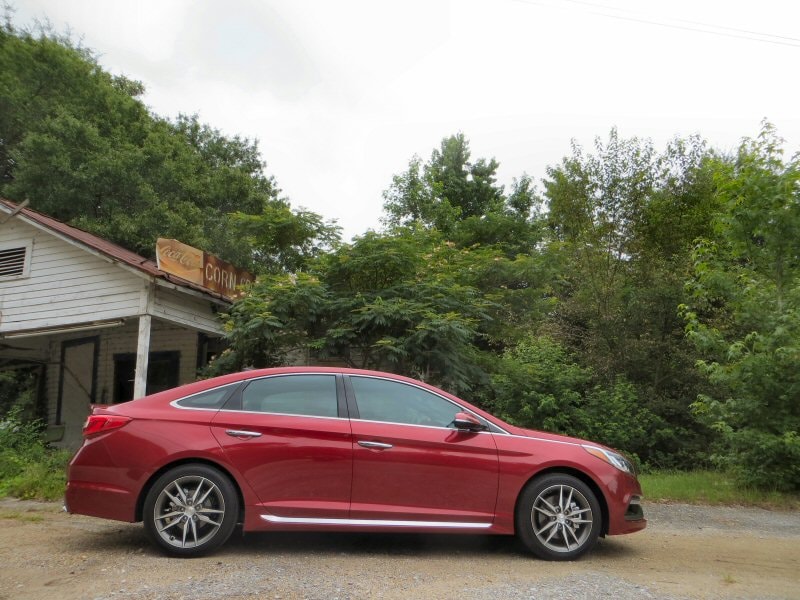
Photo by Benjamin Hunting
Numbers Aren’t Everything
The 2015 Hyundai Sonata adds a third powertrain option to the revised pair of four-cylinder power plants that have been carried over from last year. Entry-level buyers will continue to get a 2.4-liter motor, but one that has seen its output drop slightly to 185 horses and 178 lb-ft of torque. A more significant downward trend has affected the Sonata’s optional 2.0-liter turbocharged four-cylinder engine, which now posts a rating of 245 horsepower and 260 lb-ft of torque. What’s not represented by these revised figures is the decision by Hyundai to move power to the low and mid-range sections of the band, giving the Sonata a boost in everyday driving feel.
It’s not an altogether unsuccessful strategy, for while the Sonata has never been pokey it now exhibits a bit more willingness off of the line, along with very palatable fuel economy in both configurations (25-mpg city / 37-mpg highway for the 2.4-liter, 23-mpg city / 32-mpg highway for the turbo). The car's six-speed automatic transmission is also quite responsive to inputs from the Sport trim’s paddle shifters, although the performance benefits of stepping in to manually control either the base or turbocharged engine’s gear shifts are limited. Hyundai has designed the Sonata for cruising and commuting, not hairy-chested drag racing, and this is reflected by its modest momentum above 70-mph.
Despite its non-performance character, the 2015 Hyundai Sonata’s chassis has been stiffened quite a bit in comparison to the older model. What this means for drivers is a ride that feels a bit more comfortable and buttoned-down, with the narrow roads of rural Alabama near Hyundai’s Montgomery manufacturing plant providing a variety of surfaces over which to test out the sedan’s suspension. The Sonata features three driving modes – Eco, Normal, and Sport – with the most noticeable difference between the three being transmission and throttle response. Sport mode also offers quicker steering, but the Hyundai isn’t particularly engaging, simply competent and confident at speed.
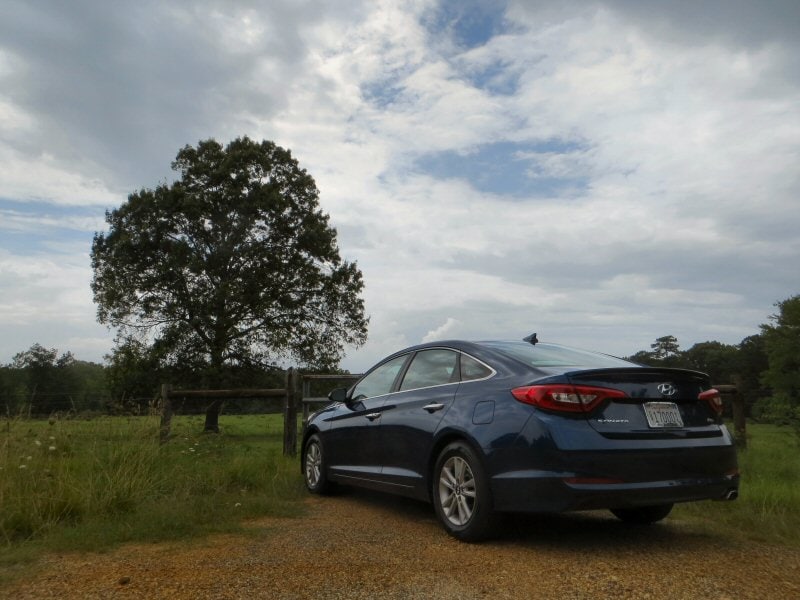
Photo by Benjamin Hunting
New Dual-Clutch Option
I mentioned that a new engine choice would be joining the Sonata family for 2015, and although my time behind the wheel with this configuration (dubbed the Eco) was brief, it has the potential to be the biggest winner for the automaker. Hyundai has married a 1.6-liter turbocharged four-cylinder to a seven-speed dual-clutch automated manual transmission, a brand-first, and one that claims a fuel efficiency estimate of 28-mpg city and 38-mpg highway. These would be segment-leading figures for the Sonata once the Eco trim goes on sale later in 2014, but better yet is how it drives. With 177 horsepower and 195 lb-ft of twist on tap, it’s fair to say that the 1.6-liter mill is just as good as the larger base motor offered by the car, with none of the balkiness that can sometimes be associated with a DCT gearbox. Although the prototype I drove was a bit rough around the edges, and somewhat buzzier than the naturally-aspirated Sonata when accelerating, at idle it was whisper-quiet – so much so that I questioned whether it featured an automated engine start/stop system (it doesn’t).
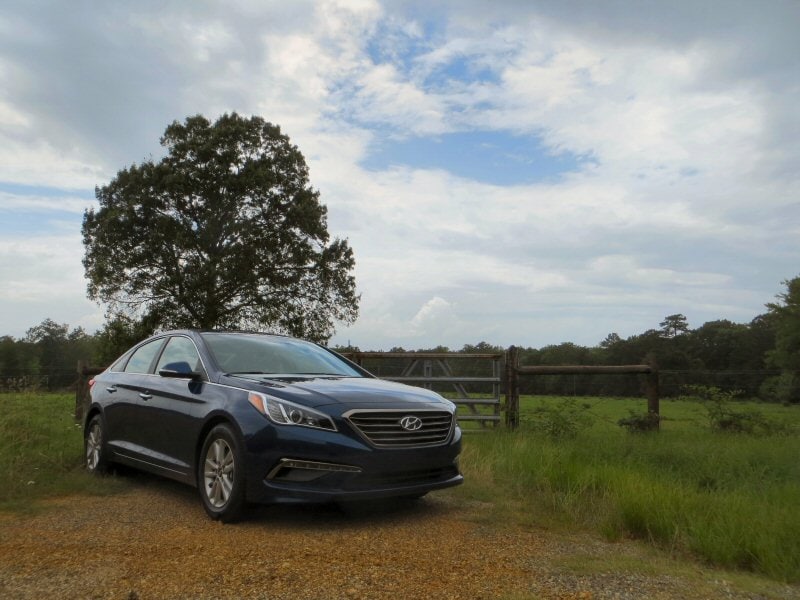
Photo by Benjamin Hunting
Still Packing Value
The 2015 Hyundai Sonata may have left elements of its engaging personality behind with this latest redesign, but what hasn’t fallen by the wayside is the car’s strong value proposition. Not only does the current Sonata’s base MSRP of $21,150 check in at $300 cheaper than a similarly-equipped 2014 model (trims have been shuffled and re-contented), but the sedan also undercuts across the board when compared to rivals like the Ford Fusion and the Honda Accord. It’s that strong position of features-for-the-dollar, combined with its excellent 10-year warranty coverage and reputation for reliability, that serves as the Sonata’s strongest draw for 2015. Add in the intriguing and efficient 1.6-liter four-cylinder option, and its solid if unexciting driving dynamics, and it would seem that Hyundai should at least be able to maintain its momentum in the mid-size sedan space.
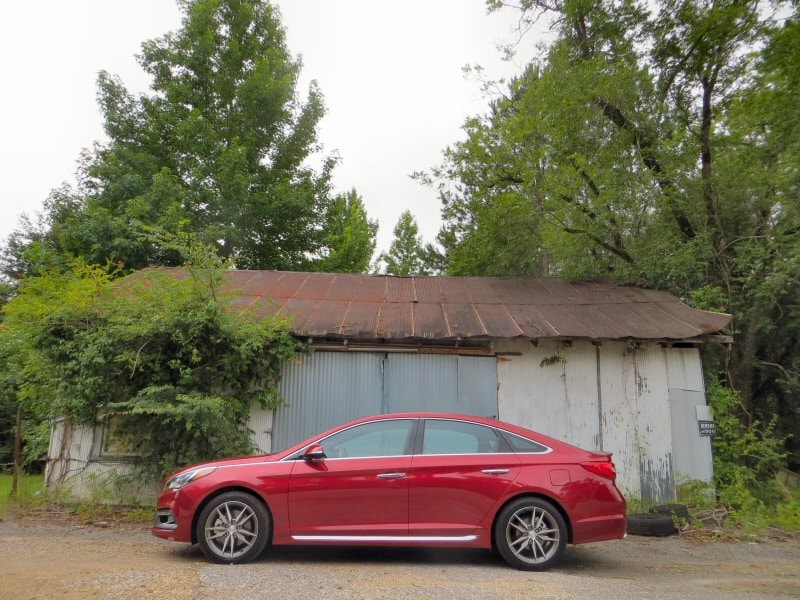
Photo by Benjamin Hunting